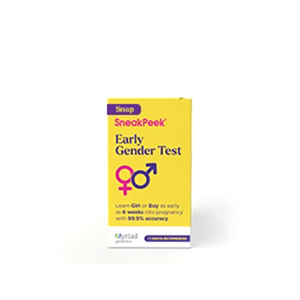Published on June 4th, 2023 and Updated on February 29th, 2024
Check out SneakPeek Gender Test to find out your baby’s gender as early as 6 weeks at over 99% accuracy1!
A chemical pregnancy is a sudden pregnancy loss that happens directly after implantation has occurred, typically before 5 weeks. They’re astonishingly common, and an estimated 30% to 50% of women will experience one in their lifetime.
Because chemical pregnancies occur so early on, their associated side effects (if they arise) are often mistaken for next month’s menstrual cycles, if they’re noticed at all. Nevertheless, discovering you’ve gone through a chemical pregnancy can lead to a host of complicated thoughts and feelings, no matter your plans for your or your family’s future.
If you’re coming to terms with a recent chemical pregnancy loss, learning its possible causes and how to recover can help ease the process. Below, we break down everything you need to know about this reproductive phenomenon to support you in making a full recovery and promoting healthy pregnancy in the future.
What is a chemical pregnancy?
As kids or adolescents, most of us learned a fairly straightforward version of how human reproduction works: a sperm meets and merges with an egg, develops for nine months, and a baby is born. But there are innumerable cytological and biochemical processes involved in reproduction, and with them, plenty of room for anomalies—including a spontaneously terminated pregnancy or early pregnancy loss.
Reproductive health experts consider chemical pregnancies to be a fairly normal part of human reproduction in general. There is no known precise cause of chemical pregnancies, and in fact, most research indicates causes may differ from case to case.
That said, it’s thought that chemical pregnancy loss may be induced by a variety of factors or conditions, including:
- Abnormal or unhealthy reproductive cells – In the earliest stages of pregnancy, an embryo rapidly develops through a process of cell division (mitosis). If a sperm, egg, or the DNA they contain is abnormal, it can complicate the embryo’s development. It’s thought that spontaneously induced pregnancy loss is one way the body corrects or adapts to these abnormalities.
- Abnormal implantation – For a fertilized egg to implant, the conditions of the uterus must be hospitable to the egg (e.g. a thick uterine lining). Moreover, the fertilized egg must implant in the uterine wall (as opposed to outside the uterus). If it doesn’t, or if the uterus’ conditions are inhospitable, the body may dispel the fertilized egg on its own.
- Hormonal issues – Pregnancy—and all reproductive activities—involve a finely-tuned feedback loop of hormones that instruct the body how to respond to protect and nurture new life. If certain hormones, like progesterone, are on the lower side, the body may not receive the signals it needs to keep nurturing a pregnancy. PCOS is another common hormonal condition associated with a higher risk of miscarriage, occurring in 30 to 50% of women (as opposed to 10 to 15% of women without PCOS).
- Infection – Infection is estimated to spur some 15% of early miscarriages, and some reproductive experts think it may also be behind chemical pregnancy. Common infections associated with pregnancy loss include:
- Bacterial vaginosis
- Influenza virus (the flu)
- HIV
- Malaria
Healthcare professionals call this spontaneous termination a “chemical pregnancy” because of how they’re discovered. After taking a pregnancy test, a provider (or the patient) might detect trace amounts of hCG (human chorionic gonadotropin), the hormone produced when an egg implants in the uterus, in a patient’s urine or bloodstream.
Miscarriage vs. Chemical Pregnancy: What’s the difference?
Miscarriages refer to a pregnancy loss that occurs in the first or second trimester, while chemical pregnancies are generally recognized as occurring before 5 weeks of pregnancy (dated back from the last menstrual cycle).
In addition to timing, it’s not known why most chemical pregnancies occur, whereas what causes miscarriages in your first trimester can be explained by select circumstances, conditions, or traumas (or a combination of several). These include:
- Maternal age
- Chromosomal issues in the fetus
- Health conditions like obesity
- Issues surrounding placental development
- Substance use or misuse
- Food poisoning (second trimester)
- Certain medications (second trimester)
- Cervical structure (second trimester)
Upon learning that they’ve experienced a chemical pregnancy, some women worry that illnesses, lifestyle factors, or even activities like high-intensity exercise could have spurred their pregnancy loss. But it’s important to remember that you are never the sole cause—a chemical pregnancy can happen to anyone, irrespective of their health status or what they decide to do with their bodies.
Who is at risk of chemical pregnancy?
While the commonness of chemical pregnancy makes it less of a condition and more of a relatively normal reproductive phenomenon, some women could be at higher risk than others. These individuals include:
- Women who are above 35 years of age
- Women with diabetes
- Women with a blood clotting disorder
- Women with PCOS
- Women with a thyroid condition
Generally speaking, suffering from a preexisting health condition could affect fertility or elevate your likelihood of a chemical pregnancy. In a similar vein, if you’ve encountered difficulty getting pregnant or have a history of miscarriages, experiencing a chemical pregnancy may indicate a broader reproductive condition.
More recent research suggests several other lifestyle factors may also come into play when it comes to early pregnancy loss. For instance:
- Women with folate deficiency are associated with an elevated risk of miscarriage, reinforcing the importance of nutrition even in the earliest stages of fetal or embryonic development.
- In another study from the US National Institutes of Health, it was discovered that couples who drank 2+ caffeinated beverages per day while trying to conceive may be at a higher risk of miscarriage.
While nutrition and lifestyle remain important parts of growing a healthy baby, sufficient evidence surrounding these specific claims remains largely inconclusive. If you’re struggling with fertility or concerned about carrying a pregnancy to term, your healthcare provider can help assess your unique circumstances and assist you with growing your family.
Chemical Pregnancy Symptoms
Because chemical pregnancies occur so early on, many women aren’t aware they’ve had one unless their healthcare provider measures their hCG levels shortly after the pregnancy loss. The few chemical pregnancy signs and symptoms reported include:
- Light cramping, which occurs as the uterus contracts to pass the fertilized egg
- Spotting, which may or may not accompany vaginal cramping. Most mild bleeding due to chemical pregnancy coincides with the arrival of the menstrual cycle, which may make it even more difficult to spot.
- Abnormally low levels of hCG – If a pregnancy test is taken at home, you may see a lighter-than-average pink line or “YES” on your at-home test. If you’re administered a test by your healthcare provider, they may detect very low levels of hCG.
Chemical Pregnancy: Treatment Options and How to Cope
In general, miscarriages only require medical care in advanced stages. Chemical pregnancies set in at a gestational age of 5 weeks or fewer, which means they typically have a less forceful impact on female reproductive organs, systems, and hormonal cycles.
That said, experiencing a miscarriage can be psychologically or emotionally painful for many women. If that’s the case for you, one of the best ways you can care for your body is to nurture your mental health.
If you’ve recently undergone a chemical pregnancy, here are some steps you can take to ensure your physical and emotional well-being:
- Talk to your healthcare provider – Of the countless women who experience chemical pregnancy, many of them go on to conceive and carry a healthy baby to term. That said, if you’re concerned your chemical pregnancy may be linked to more far-reaching fertility issues, talk to your doctor. They’ll be able to counsel you on the best course of action for diagnosing any existing issues and helping you pursue your family planning goals.
- Talk to loved ones – Whether it’s your significant other or a close friend, vocalizing any mixed emotions you might be feeling may help you process them in the event of a chemical pregnancy. For many women, opening up may also be an opportunity to recognize what they want for themselves when it comes to family planning (regardless of whether or not they were initially planning to get pregnant).
- If you’ve been trying to conceive, consider taking a break – In the event of a miscarriage, some healthcare providers may advise patients to give their body time to recover before trying to get pregnant again. While the recovery protocol for chemical pregnancies and miscarriages is distinct, you might consider letting your body rest.
Remember, the vast majority of chemical pregnancy symptoms are mild (sometimes unnoticeable!), and your reproductive system is likely to assume its regular monthly programming swiftly after one occurs. However, if you want to take a break before trying to get pregnant again, there’s no shame in taking whatever amount of time you need to ensure a healthy pregnancy in the future.
Take It Step By Step with SneakPeek
Whether you’re planning a pregnancy or are just beginning to think about parenthood, SneakPeek can help you arm yourself with the clarity you need to move forward whenever you’re ready.
With SneakPeek’s at-home Early Gender DNA Test, new parents can learn their baby’s gender as early as 6 weeks into their pregnancy—with over 99% accurate1, DNA-based gender blood test results. Here’s how it works: you’ll take a sample at home, send it to SneakPeek labs, and we’ll process your results the same day we receive them.
Plus, all SneakPeek tests are triple-reviewed and data-protected. As OBGYN’s #1 recommended early gender test, we’re trusted by more than 1 million moms in the country.
See our complete range of at-home prenatal tests by browsing our full collection today.
Sources:
- Verywell Health. What Is a Chemical Pregnancy? https://www.verywellhealth.com/chemical-pregnancy-5116868
- Parents. What Is a Chemical Pregnancy? https://www.parents.com/pregnancy/complications/miscarriage/what-is-chemical-pregnancy/
- Healthline. What’s a Chemical Pregnancy? https://www.healthline.com/health/pregnancy/chemical-pregnancy
- LibreTexts Biology. 23.2 Embryonic Stage. https://bio.libretexts.org/Bookshelves/Human_Biology/Human_Biology_(Wakim_and_Grewal)/23%3A_Human_Growth_and_Development/23.3%3A_Embryonic_Stage
- ScienceDirect. Spontaneous miscarriage in first trimester pregnancy is associated with altered urinary metabolite profile. https://www.sciencedirect.com/science/article/pii/S2214647417300302
- National Library of Medicine. Pregnancy in polycystic ovary syndrome. https://www.ncbi.nlm.nih.gov/pmc/articles/PMC3659904/
- National Library of Medicine. The role of infection in miscarriage. https://www.ncbi.nlm.nih.gov/pmc/articles/PMC4664130/
- National Institutes of Health. Folate Deficiency Associated with Higher Early Miscarriage Risk.
- https://www.nichd.nih.gov/newsroom/releases/miscarriage_risk
- National Institutes of Health. Couples’ pre-pregnancy caffeine consumption linked to miscarriage risk. https://www.nih.gov/news-events/news-releases/couples-pre-pregnancy-caffeine-consumption-linked-miscarriage-risk

Shop Our Products
SneakPeek aims to provide the most accurate and up-to-date information to help our readers make informed decisions regarding their health before, during, and after pregnancy. This article was written based upon trusted scientific research studies and/or articles. Credible information sources for this article are cited and hyperlinked.





